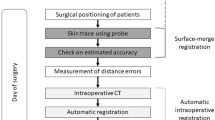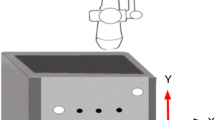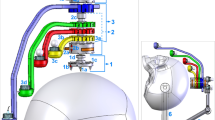Abstract
Neurosurgeons sometimes find it difficult to locate tumors precisely during microsurgery, particularly tumors located in the brain parenchyma because of the absence of boundaries in this region. Image-guided neurosurgical techniques conducted with the help of neuronavigation systems have been developed and have gained importance recently. Accuracy is vital during image-guided neurosurgery. We used a phantom to evaluate the errors introduced during navigation. The three errors evaluated were skin-shift, marker-gap, and table-rotation errors. The skin-shift error occurs if the fiducial markers positioned on the scalp move when the head is fixed to a head holder with head pins. The marker-gap error occurs when the marker ball is positioned incorrectly in the marker socket. The table-rotation error occurs when the operating table is rotated for obtaining an intraoperative MR image and then returned to its original position. Our results indicated that skin shift decreased the navigation accuracy by an error of more than 4 mm, and the gap between the marker ball and the socket resulted in a decrease in navigation accuracy by an error of more than 5 mm. The table-rotation error was found to be negligible. The errors can be avoided by ensuring that the fiducial markers are positioned appropriately on the scalp and the marker ball is fitted well in the marker socket. A phantom is useful for evaluating accuracy, particularly for evaluating errors intrinsic to different operating rooms. Periodic quality assurance by use of a phantom in each operating room might aid in maintaining the accuracy of neuronavigation.






Similar content being viewed by others
References
Nagashima Y, Hirose S, Suzukawa H, Naemura K, Takanobu H, Muragaki Y, et al. Improvement of a navigation system for the neurosurgery in the intraoperative MRI-equipped operating theater. J Jpn Soc Comput Aided Surg. 2003;5:331–2.
Iseki H, Muragaki Y, Nakamura R, Ozawa N, Taniguchi H, Hori T, et al. Intelligent operating theater using intraoperative open MRI. Magn Reson Med Sci. 2005;4:129–35.
Muto S, Ando H, Nagashima Y, Uematsu M, Suzukawa H, Nakamura R, et al. Clinical application of the navigation system for the neurosurgery in the intraoperative MRI-equipped operating theater using reflective ball markers. J Jpn Soc Comput Aided Surg. 2004;6:367–8.
Nagashima Y, Hirose S, Suzukawa K, Naemura K, Takanobu H, Muragaki Y, et al. Accuracy evaluation of navigation system during neurosurgery at open MRI theater and improvement of its maneuverability. J Jpn Soc Comput Aided Surg. 2004;6:5–13.
Brain Lab AG. Clinical user guide rev. 1.0. Vector vision cranial ver. 7.5J. Feldkirchen: Brain Lab AG; 2005.
Author information
Authors and Affiliations
Corresponding author
About this article
Cite this article
Watanabe, Y., Fujii, M., Hayashi, Y. et al. Evaluation of errors influencing accuracy in image-guided neurosurgery. Radiol Phys Technol 2, 120–125 (2009). https://doi.org/10.1007/s12194-009-0053-6
Received:
Revised:
Accepted:
Published:
Issue Date:
DOI: https://doi.org/10.1007/s12194-009-0053-6




